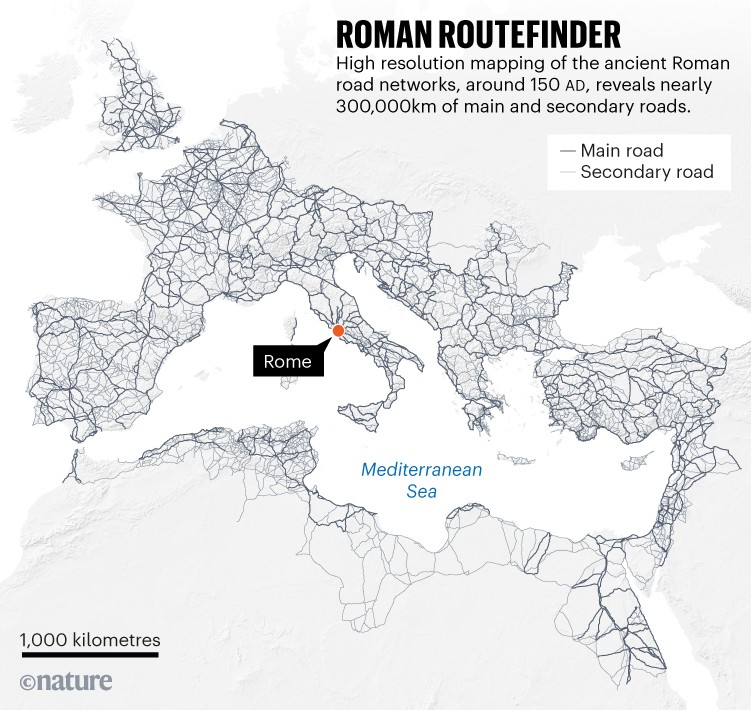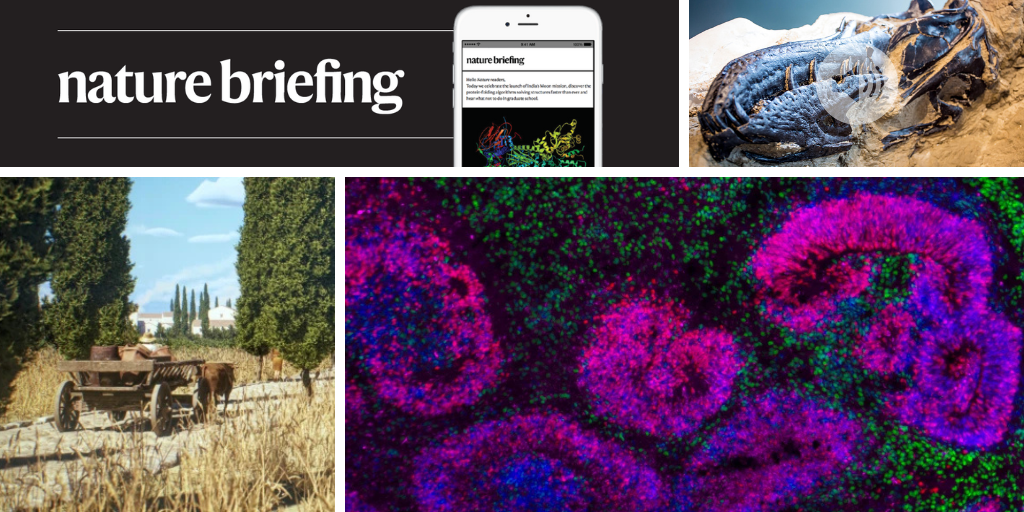You have full access to this article via your institution.
Hello Nature readers, would you like to get this Briefing in your inbox free every day? Sign up here.

Source: itiner-e.org
A high-resolution ‘Google Maps’ for Roman roads includes nearly 300,000 kilometres of viae Romanae. It brings together fragmented data sets to show the full glory of the network that connected the empire around ad 150, when it was at its biggest. But “although the roads are one of the best-known aspects of Roman history, it’s surprising how many details about them we still don’t know,” says historian Catherine Fletcher. The data set reveals that the locations of only 3% of Roman roads are known with certainty.
Scientists have created the most detailed maps yet of how our brains differentiate from stem cells during embryonic development and early life. In a collection of five papers, they tracked hundreds of thousands of early brain cells in the cortices of humans and mice, and captured with unprecedented precision the molecular events that give rise to a mixture of neurons and supporting cells. “It’s really the initial first draft of any ‘cell atlases’ for the developing brain,” says brain scientist Hongkui Zeng, a co-author of two of the papers. Researchers can now “mine the data” to study neurological conditions such as autism and schizophrenia, says Zeng.
Features & opinion
Only an estimated 3% of US state legislators have backgrounds in science, engineering or healthcare — but that might be about to change. One group that specializes in getting scientists into office says that it has seen applications skyrocket. Some physicians and scientists who are running say they have been inspired by issues such as pandemic-era health protections and — perhaps ironically — the politicization of science and public health. “Politics came for us,” says paediatrician Annie Andrews. “You can’t fight bad politics by staying apolitical.”
A person who holds immortality within their grasp considers whether to let go in Outside the window and a scientist and her lab rat seize onto hope in Anosophoros.
Nature | 2 min read & Nature | 6 min read
A fossil once assumed to be of a young Tyrannosaurus rex is in fact that of a nearly full-grown adult of a different species altogether: Nanotyrannus. The finding has implications for decades of published science, says palaeontologist Lawrence Witmer. “The exciting thing about palaeontology is that if we’re willing to wait long enough, somebody’s going to find something,” Witmer tells the Nature Podcast. “Somebody’s going to find a new fossil that’ll help us resolve the debate or send the debate off in a crazy new direction.”
Nature Podcast | 29 min listen
Subscribe to the Nature Podcast on Apple Podcasts, Spotify or YouTube Music, or use the RSS feed.
Today our penguin puzzle sees Leif Penguinson squirrelled away somewhere in the stunning landscape of the Valley of Ten Thousand Smokes in Alaska, where waterfalls skirt the pyroclastic flow from the 1912 Novarupta eruption. Can you find the penguin?
Remember! Leif is not a real penguin and so not subject to the real laws of penguin physics. The answer will be in Monday’s e-mail, all thanks to Briefing photo editor and penguin wrangler Tom Houghton.
This newsletter is always evolving — tell us what you think! Please send your feedback to [email protected].
Thanks for reading,
Flora Graham, senior editor, Nature Briefing
• Nature Briefing: Careers — insights, advice and award-winning journalism to help you optimize your working life
• Nature Briefing: Microbiology — the most abundant living entities on our planet — microorganisms — and the role they play in health, the environment and food systems
• Nature Briefing: Anthropocene — climate change, biodiversity, sustainability and geoengineering
• Nature Briefing: AI & Robotics — 100% written by humans, of course
• Nature Briefing: Cancer — a weekly newsletter written with cancer researchers in mind
• Nature Briefing: Translational Research — covers biotechnology, drug discovery and pharma


